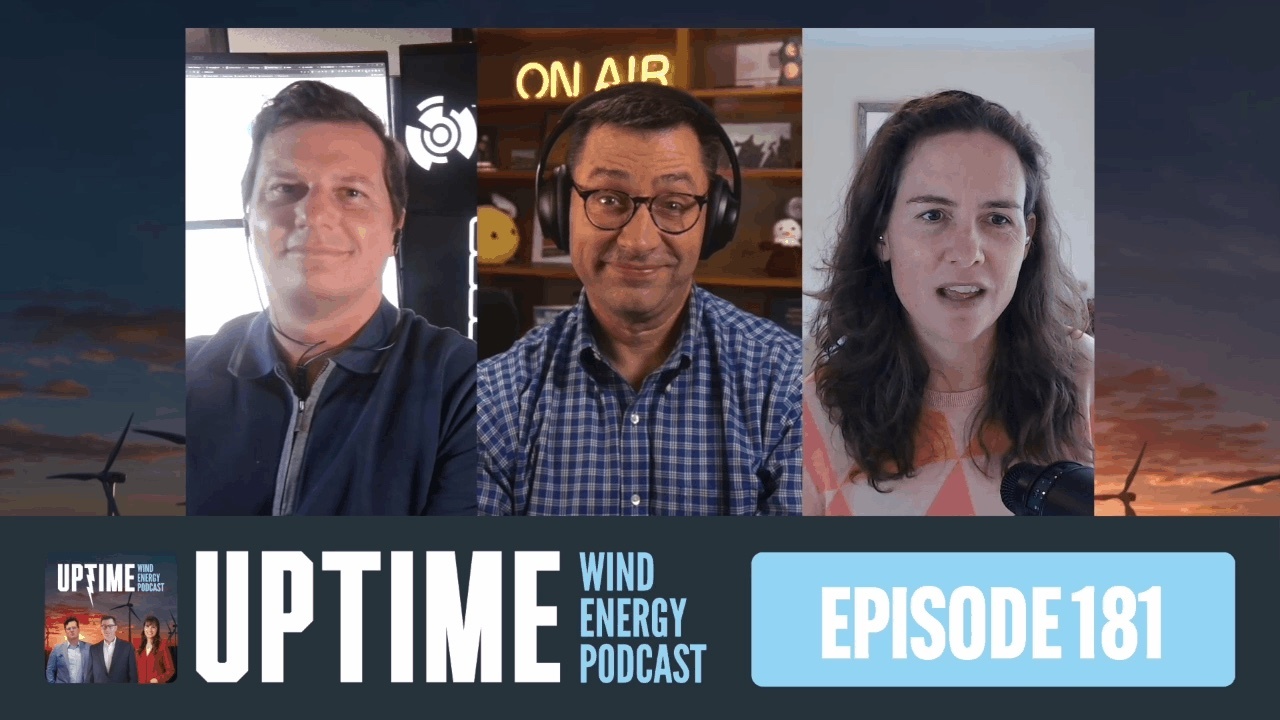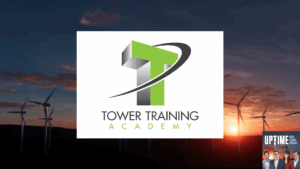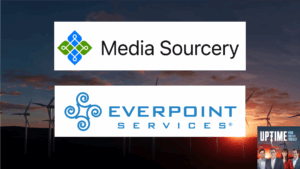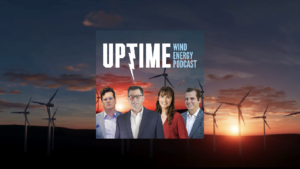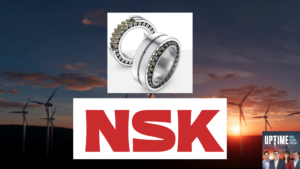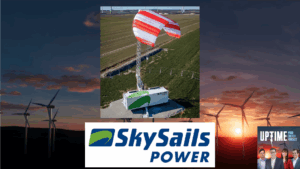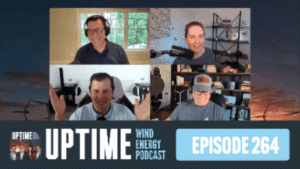Major offshore wind developer Ørsted’s ambitious U.S. projects are being battered by a perfect storm of supply chain breakdowns, soaring interest rates, and evaporating tax credits. The dire situation has already led to lengthy delays and billions in potential losses on high-profile projects like Ocean Wind. Down in the Gulf of Mexico, the three BOEM offshore auction plots only received 1 bid…Phil Totaro walks us through the bidding and what lies ahead. Rosemary Barnes explains the innovative next generation of sails for transport ships to reduce emissions. And our wind farm of the week is the Twin Groves Farm in Illinois!
Podcast: Play in new window | Download
Sign up now for Uptime Tech News, our weekly email update on all things wind technology. This episode is sponsored by Weather Guard Lightning Tech. Learn more about Weather Guard’s StrikeTape Wind Turbine LPS retrofit. Follow the show on Facebook, YouTube, Twitter, Linkedin and visit Weather Guard on the web. And subscribe to Rosemary Barnes’ YouTube channel here. Have a question we can answer on the show? Email us!
Pardalote Consulting – https://www.pardaloteconsulting.com
Weather Guard Lightning Tech – www.weatherguardwind.com
Intelstor – https://www.intelstor.com
Uptime 181
Allen Hall: I assume everybody has seen the full self-driving 12 that Elon Musk put on X the other day where the car was essentially driving itself and I thought, well, Rosemary is gonna put in our order for the cyber truck. All will be right with the world.
Rosemary Barnes: It’s, I’m not the biggest fan of, of the aesthetics of the cyber truck.
Allen Hall: Well, you’re probably the only person on the planet. ’cause they have a five year wait list for those trucks.
Rosemary Barnes: Yeah. Yeah. I, I actually, I I can barely believe that they have orders for that, but it’s just been an example where I’ve had to. To accept that I don’t, I don’t have my finger on the pulse of what truck drivers want, want their trucks to look like.
Allen Hall: Yeah. Well, Phil, have you, have you placed your order for the new Tesla cyber truck?
Phil Totaro: I have not. I went in probably the opposite direction. I bought myself an electric scooter. It goes 40 miles an hour. About what? 65, 70 kilometers an hour. Which is extremely fast and it’s fun.
Rosemary Barnes: Wait, do you mean a scooter that you stand on? Like you know, not, not like a little tiny motorbike, but a,
Phil Totaro: A standup scooter
Rosemary Barnes: That’s too fast.
Phil Totaro: I’ll tell you what, if, if you, if you look at the side of my face, you might see the remnants of a face plant that I did about three days after I got the thing, but, I’m better at riding it now, and it’s, it’s, I got one and it still didn’t, didn’t matter, but it’s, it’s great actually.
So I, I have not I don’t know that I’m planning to invest in a cyber truck anytime soon.
Allen Hall: Phil, please, please buy a helmet.
Phil Totaro: I have one.
Allen Hall: Well, Ørsted is having a very bad month or so. Number of problems going on there. They have, their stock has dropped the most ever. About 20, a little over 20%. Do some, some problems mostly in the United States. Supply chain challenges on projects like ocean, wind, ones, sunrise, wind revolution, wind, and having deliveries for mod piles is evidently is a problem.
There’s a delayed, there are so many things happening with or at the moment, Phil, and a lot of this. It seems to be things that are out of their control, supply chain issues, interest rates, also investment tax credits are not coming out to what they thought they would be. And so Mads Nipper, the CEOof Ørsted in a call and when you’re, when this podcast comes out, have been a couple days ago he was not happy.
And they’re considering abandoning future projects. In the US because of profitability criteria is not being met. And they do plan to finish up the projects they signed up to in the northeast of the United States because they have sunk costs. And I’m not not sure that makes sense, but, we’ll, I think Ørsted will finish those projects.
But they’re looking at financial impact of a little over $2 billion for the, these three wind projects that are happening in in the United States. Phil, I, when all this went down earlier today, the news reporting was insane. And everybody was trying to figure out what happened to Ørsted because as a company that is so knowledgeable in wind period and renewable energy they have really hit a real impasse in the United states.
Phil Totaro: Indeed. And as Mads Nipper came out and said, these are things that are unfortunately, largely out of their control. They need the supply chain to meet their contractual obligations in terms of component delivery that’s contributing a little over, you know, has the potential to contribute a little over 700 million in impairments.
If they don’t get back on track. They’re already delaying one of those three projects to 2026 now. I believe it’s the the ocean wind is now not slated to to come online until 2026 as a result. And you’re, you’re seeing, you know, as you’ve also indicated this in investment tax credit which is, is slightly interesting and odd because you know the rules.
With this inflation reduction Act, the rules for the production tax credit and the investment tax credit were never quite precisely finalized. And we’re still technically waiting for official internal Revenue Service confirmation about what the, the qualification criteria are going to be.
What it’s looking like at this point is that Ørsted suggesting that perhaps the investment tax credit’s not gonna be as lucrative as it would have been for them. The other challenge to that is they’re not gonna be able to take advantage of a lot of the domestic content production benefits that come from the production tax credit side of it.
Particularly because we don’t have the necessary investment in the the blades, the nael, the, the Monopile and Jacket Foundation, fabrication and manufacturing capabilities here in the United States to be able to support even the projects that are, that are being worked on right now. We’re still having to source a lot of those components from Europe and potentially from Asia, but mostly Europe.
Bring them over and, and install them. So this is also potentially what’s contributing to those supply chain issues. But you know, all of those things coupled with this high interest rate environment that we still find ourselves in, where, you know, I mean, look, inflation still exists. It’s been mostly dealt with.
And yet the US Federal Reserve also insists on continuing to send signals to the market that they want to continue raising interest rates, albeit modestly. But you know, this is in, this is a, a combination or what Mads Nipper from, from Ørsted referred to as a perfect storm of issues that have.
Created an unfriendly environment for investment in offshore wind in the United States at this point. And, and that’s going to be not only a challenge for Ørsted, but frankly a challenge for everybody.
Allen Hall: Well, what is, what is the follow-up in the short term here? You know, Ørsted, financially these projects, these offshore projects in the, in the US have an impact on their cap table.
Like the valuation of Ørsted is dropping at a remarkable rate. Over the last year or so, it has dropped a, a good amount enough to be worrisome, and I think investors are starting to get a little bit worried about the future. Now, obviously, Ørsted is backed by Denmark and, and is Big driver in the Danish economy somewhat.
Novo Nordisk sound like they’re taking over that top role because of some of the pharmaceuticals that are happening up in Denmark, but in, in terms of just the business outlook and what they do next, I, I don’t think Mads Nipper is wrong about this. I just don’t know what he’s gonna do about it.
Phil Totaro: The, the challenge here is these are things that are out of their control largely.
You know, you’re, you’re seeing a situation where, you know, yes, they can, you know, threaten certain things to the supply chain, but ultimately they are dependent on the supply chain to be able to deliver the components. You know, on the contractually ob obligated schedule, you know, once the contracts have been signed and once you know, the final investment decision or f i d is, is decided upon that triggers a certain schedule of dates that everybody that’s involved in the project has to be able to abide by.
And if the supply chain is still gonna be stung by, you know, high input costs, either again, inflation related or the availability of materials or what have you. You know, the, the supply chain, obviously it has its own set of profitability issues, but it’s starting to spill down into, you know, the, the project developers and, and the rest of the.
Kind of value chain in, involved in both onshore wind, offshore wind, solar, et cetera. So this is, this is going to continue to be a challenge. You know, I was asked a similar question earlier today. What can be done? And at the end of the day, this is all now kind of in the hands of the US Federal Reserve.
I mean, that’s the one knob that can be turned here, that will start having a material impact on a lot of these issues. If we can start lowering interest rates. It’s gonna unlock a lot more investor money and it’s gonna unlock a lot more CapEx investments in the fabrication facilities as well that are needed in the United States to be able to handle you know, the, the manufacturing and fabrication of, of components domestically for these projects that will in turn start.
You know, easing pressure on the supply chain companies you know, input costs lower interest rates will, will have a material impact on you know, lowering their input costs, which will then also again contribute to lower CapEx on, on a project. You know, lower interest rates also mean, you know, lower cost of money and the potential to be able to get back to the power purchase contract prices that, you know, were originally being agreed upon.
And now companies are, are trying to pull out of of those power purchase contracts. So these are the. This is the one knob that I think can be turned is, is starting to lower interest rates. You know, it doesn’t have to be a huge waterfall, but you know, if you’re, if you’re gonna continue as a Federal Reserve indicating that you’re gonna increase interest rates in an environment where everybody’s already, you know, backed out of a lot of the investments or trying to back out of a lot of the investments that they were committed to this is not gonna.
This is gonna delay the, the, the takeoff of the industry until, you know, well into 2025 or 2026, we’re, we’re at least seeing, you know, this, this is a setback that’s already impacting us by a good six to nine months from now. It’ll probably be about the middle of next year before you see anybody diving back in whole hog in the US offshore wind market.
Rosemary Barnes: Do you think that we’ll have to see a difference in the way the contracts are written going forward? Because I remember a little while ago we talked about some negotiation with an offshore wind developer that was Being asked to guarantee a certain output of energy, and we discussed how you’d be crazy to, to guar to write a contract like that, that locked you into something that you had no control over because you can’t control how much wind there is in a year.
So your contract can, you know, unless you’re an, an idiot, you would write your contract so that it said you have, you know, other performance metrics that you can control rather than, you know, something that relies on Mother Nature. In the past, maybe people thought that supply chain costs and interest rates and tax credits were something that could be, you know, accurately predicted ahead of time.
We’re saying it’s not just the wind industry that has this problem. We have, it sounds really familiar to me, like the same reason why the building industry in Australia is having a lot of problems because there were so many fixed price contracts and the price went up and everyone just went outta business in, in response.
They just couldn’t. You know, they, they could not deliver on those contracts. So yeah, obviously these projects at Offshore Wind farm is a bit more of a big deal if that gets canceled compared to if somebody’s home doesn’t get built at the you know, the price that was agreed. But, you know, moving forward, aren’t we crazy to say, I’m going to take all of the risk for supply chains, interest rates and everything on the, you know, on the developers’ side.
Shouldn’t they be writing into their contracts that it has the price, final price has something to do with where those those, you know, those indicators go in the future.
Allen Hall: But don’t we have Avangrid as a good example there where they got pressured into low PPAs and everything went up and they, they essentially walked away.
Ørsted is not saying they’re gonna walk away, but I think here, here’s the interesting company that hasn’t said anything yet. Equinor. What does Equinor doing in the middle of this? Now that they see Ørsted having trouble and Avangrid walking away, Equinor’s being really quiet. Empire Wind not hearing a lot about what are they doing?
Are, are they taking a different avenue? I know they’re really tied to New York and, and that’s a particular problem on its own, but, There’s not a lot of players in this market space, and two of the big ones are having really strong financial difficulty right now.
Rosemary Barnes: Yeah. Well, isn’t the difference you know, who’s got diversification beyond this?
You know, one, one market with these problems, Equinor’s got all, you know, they’re laughing all the way to the bank with all of their oil and gas money sitting there. It must be a blip to them. And a yeah, perfect opportunity to. Wear a few losses and take the whole market. And in a couple of years, they’re the only ones with any experience building offshore wind farms.
Allen Hall: So are the only winners in offshore wind, the oil and gas companies?
Phil Totaro: That’s a great question. And I think long-term it may be the case where they are the majority owner or investor In a lot of the projects it’s, it’s hard for pure play wind company. To, to do offshore wind project development that is so capital intensive.
And in a market environment that makes it, you know, like, like Rosemary just said, I mean, they, nobody else can get the requisite experience to, and obviously Ørsted has plenty experience with what they’ve done in Europe and, and Taiwan, et cetera. They, there’s still specific things that are unique to each market.
I mean, you see Brazil looking to build up, you know, they, they have the second biggest pipeline now in terms of proposed projects in the world behind China. You know, you’re, you’re at a point where, You know, in, in any other market you know, you’re, you’re not necessarily going to have the opportunity to gain the experience if you’re not able to play in the market.
If deep pockets are the only thing that are, is going to ensure that you can play in the market, then it, it basically does come down to sovereign wealth funds and, or, you know, the oil and gas companies, you know, that may have a sovereign wealth fund behind them, like you know, Equinor or. You know, perhaps some Saudi companies that will end up partnering with somebody that, that has some offshore wind development experience.
But it’s, it’s interesting because that is something that, that could occur out of, out of all of this is and, and also potentially answers the question why did, Some of these major oil and gas companies like BP and Equinor bid so much for the lease rights in places like New York and, and the northeast of the United States.
It’s because they understand fundamentally the value of having the offshore lease rights. So yeah, it’s that’s, that’s kind of an interesting notion at at this point. I, I think it’s challenging.
Allen Hall: I, I hate to get all conspiratorial here, but you kind of wonder no one, no one in the administration is, is is batting an eye at this?
This is happening a week after they announced a billion dollars going to carbon capture. And where’s the DOE? Nothing. Eversource left the marketplace weeks ago, right? So the Americans are abandoning in this re relatively quickly. I don’t know what they have left and I haven’t heard any sort of leadership from the DOE or BOEM or anybody say, Hey, this is a problem when you get on this thing.
Nothing. It’s been complete radio silence.
Phil Totaro: And I won’t suggest conspiracy theories per se, but there definitely is. There’s a, you know, I was asked earlier today whether or not I think the US offshore wind market is in a crisis, and I have to agree with that sentiment that this is a short term crisis that we are facing.
And we’re, the industry is the only one that’s kind of bearing the brunt of it to every, like you said, I mean, the administration’s just kind of shrugging their shoulders. Like we’re saying, Hey, we’re, we’re in a crisis here, guys, and, and they’re still off running tenders for, you know, the Gulf of Mexico.
Allen Hall: Hey uptime listeners. We know how difficult it is to keep track of the wind industry. That’s why we read PES Wind Magazine. PES Wind doesn’t summarize the news. It digs into the tough issues. And PES Wind is written by the experts, so you can get the in-depth info you need. Check out the wind industry’s leading trade publication PES wind at peswind.com.
The first offshore wind development rights auction for the Gulf of Mexico by the Biden administration concluded with a single winning bid of $5.6 million. German company RWE secured the rights to 100,000 acres off Louisiana with two lease areas off of Texas receiving no bids. Now, Phil we you were live streaming this as it was going on on LinkedIn.
And my first re on the first pass the individually low, and I replied, you know, wake me up when they get to 100 million. Well, they didn’t get anywhere near that amount. What happened?
Phil Totaro: Yes. I guess you’re still asleep then, because Yeah, I, I if we, if we go back to, you know, our prediction from about a month ago as to what was gonna happen, we said that the prices were likely to come in, you know, below California.
Levels, but still decently healthy because there’s, there’s certain plays in doing Gulf of Mexico projects that make sense. If you’re doing things like hydrogen production or, you know, you’ve got at least some certainty in terms of power offtake in Ercot or the Southwest Power Pool. But the Texas Galveston one in two sites didn’t even get any bids at all.
And there were two participants in the auction. RWE was one of them. There were a total of three bids, and they ended up winning for $54 and something per acre, which is practically unheard of. That’s that’s almost as dirt cheap as it was 10 years ago. When. You know, dominion Energy went after the the coastal Virginia Offshore wind site and, and US wind got the, the mar wind project sites.
So I, I am, I’m shocked honestly, because I was, you know, it’s funny, I was expecting to be live streaming all day and that ended up taking about an hour and 10 minutes, and it’s. So, you know, as we were just talking about with Sted, I think this is reflective of the current situation and I, I said this to a, to a journalist earlier in an interview where I.
He was asking whether or not you know, basically, or basically he was asking what happened and I said, you know, look, at the end of the day, I think all these inflation pressures, the CapEx issues, the, the, you know, lack of certainty all kind of played into you know, increasing the, the risk to a point where, you know, the 15 or so companies that were even registered for the tender didn’t even bother participating.
I mean, the oil and gas companies completely sat out and RWE looks like they got a really great deal. But keep in mind that what RWE won the rights to is also a project where there’s some money that’s been allocated to a company in Louisiana. To actually do hydrogen production and kind of a, a power to x type of an application.
So they have a, a route to market for the power, or at least a portion of the power that they’re gonna generate. And then they can sell the rest of it to the southwest power pool and or ear cott, depending on how they wanna hook up the, the cables. So, you know, this is, this is interesting and again, quite shocking.
That this is the way it turned out.
Allen Hall: Well, is it driven by the energy prices locally in Louisiana and Texas where they’re relatively low compared to New York that putting offshore wind in today is at least the numbers we’re hearing on the East coast or somewhere around a hundred dollars a megawatt hour that doesn’t play well down in Texas and Louisiana.
Those numbers are really high. Is that the drivers, that they can’t deliver electricity to the grid there because those two places can get electricity much cheaper. And that it would have to take some sort of green hydrogen approach to make sense for an RWE to go ahead and do this.
Phil Totaro: It’s part of it.
So there were four or five factors that kind of influenced the, the risk associated with these Gulf of Mexico projects in general. One was weather, obviously there’s more hurricane prone, you know, area. The second one is the soil conditions. Although interestingly, I didn’t think that was as much of an issue for the oil and gas companies.
And one reason why they would have plowed into this because. You know, again, as we, we talked about with the Ørsted thing, they wanna be able to own the rights to lucrative project sites where, you know, they could use the, the power generation to power their offshore rigs. And so they’re used to putting rigs in soft soil conditions in the Gulf of Mexico.
So, you know, what’s the issue with, you know, for them to, to handle you know, offshore wind jackets as opposed to, you know, oil and gas jackets re tension like platforms. So, you know that. It was a bit of a, a head scratcher that we didn’t see more engagement on, on that. But again, I think that goes back to the profitability issues now.
Like I’ve been saying, you know, the weather risk, the, the soil conditions, those were two of the risks. The power offtake was a third one, and that does play into it where yes, you’ve got. Average price in ear cot right now is around, you know, $32 a megawatt hour. And if you’re talking about building a project that’s 80, 90 or a hundred dollars a megawatt hour in, in an offshore wind, p p a, that’s not as attractive.
But again, the the, I figured that the oil and gas companies could have leveraged some of that power. For their oil and gas platforms, which is exactly what they’re doing in the North Sea, in in Europe. And they’re actually talking about doing in, in different places in China as well to support some of their oil and gas extraction activities.
So that one still is, is a bit confounding, but I think overarching all of this was the interest rate environment. And the remnants of inflation that the industry is still dealing with. I think this, this whole issue that we talked about with Sted, I think we covered a lot of what has been on the minds of a lot of project development companies and what’s kind of led them to kind of pull back at this point.
So my question to. Is really like, why did we go forward with an auction when over the past six or nine months it looked like we were heading in this direction where, you know, initially there were some signals that companies either weren’t gonna participate or didn’t wanna bid that high. To be honest, I thought that that was really just people playing the market.
You know, they, they were trying to send signals to their competitors through, you know, press releases and public statements trying to, you know, game the system a little bit and, and game the auction. But at the end of the day, this is a, a complete disaster when, you know, the government expected, you know, hundreds of millions of dollars in additional revenue like they got for these project sites in, in the northeast or even in California.
They got $5.6 million and now these Texas sites, you know, presumably they get re-tender at some point in the future. But I mean, it’s, it’s a bit of a it, I’d have to say it’s a bit of a disaster.
Lightning is an act of God, but lightning damage is not actually is very predictable and very preventable. Strike Tape is a lightning protection system upgrade for wind turbines made by weather guard. It dramatically improves the effectiveness of the factory l p s so you can stop worrying about lightning damage.
Visit weather guard wind.com to learn more. Read a case study and schedule a call today.
Allen Hall: Our cargo ship named Pyxis Ocean Set Sail this month with wind powered quote unquote wind wings technology aimed at reducing emissions. This ship had large steel sails that were designed by bar Technologies and produced by Yara Marine.
They are expected to, to generate about 30% of the emission savings for this ship. That’s a really cool idea. We’re using some, some sails, some new advanced sails. Now there’s a bunch of ships that are gonna be trying this technology, but this is really the first one to, to do it in earnest. If you watch online and if you can go online on YouTube and, and watch win-wins it’s kind of a cool system.
Rosemary, the, the, the quote unquote sails or wind turbine blades is what it looks like. Are on pivots, and so they can rise up and, and be used to sail, and then they get close to shore or they have to go underneath the bridge. They just kind of fold down back on deck. So that’s one of the big problems with any sort of sailing vessel today, because everything’s run off some form of, of petroleum product that.
How do you go underneath the, all the, the bridges and things you have to go to, to get to the docks? So the system is really interesting and I wanted to get your take on using steel for these, for these wings. It seems like there’s, if you look at, again, I’ll go back to the YouTube video that I saw, which is, is a big beam in the middle and maybe the outside shell, maybe plastic or fiberglass, but does that make sense in, in terms of just cost?
Is, is that what’s driving? All the use of steel and, and does, does it make sense to make something as, as rigid as that, as, as a sail instead of something that is more like a fabric when coated wind turbine, like we saw from GE a couple years ago where the, you could slide on and on the fabric to make a sail.
Rosemary Barnes: I think it’s more, the question is probably more not should you make it outta steel, but you probably should be always questioning why you wouldn’t make something out of steel or another, you know, low cost material. So, you know, the wind turbine blades on, on, on blades are on a wind turbine, have a really, a lot of good reasons why they need to be light.
You know, they’re sitting all the way up in the air on the tower and the heavier the blades are, the stronger the tower, the foundation, all of the bearings, you know, there’s all the, the hole. Yeah, a lot of, a lot of stuff needs to be sized bigger if you have heavier blades. So you see this drive to get lighter blades ’cause it’s not just that yeah, like adding material like carbon fiber to reduce the, the weight.
It increases the cost of the blade, but overall you end up with the cheaper project because it takes cost out of everything else. But if you’ve got a sail just directly stuck on a, a ship, it doesn’t have those same drivers to be light, I mean, We think about shipping containers are not, you know, particularly lightweight, right?
Because it doesn’t really matter. You know, once something’s floating in a, in a ship, the weight is not nearly that important as it is in other applications. Like yeah, on a wind turbine or in transport like cars or something like that. So it makes sense from that point of view to me. Also you gonna be operating in a very corrosive environment.
So I guess they’re trying to use materials that ship builders are already familiar with. Like, you wouldn’t, you wouldn’t give this wing to a wind turbine manufacturer to make the blades. You would give it to a ship builder because they’re the ones that are gonna know what are the alloys that you can use that you know are gonna survive the environment.
And I’m assuming that you’re gonna be doing at least some of the manufacturing. At the port close to where it, you know, first, first disembarks, you’re not gonna be, you know, making it in some factory inland and then, then driving it over there. So you need to know what manufacturing methods are, are common, and yeah, available in the, the place that you need it.
Allen Hall: There was another project called Ocean Wings. It, it’s very similar and I think they were using fabric at the time. And they have different approaches, but there’s not just one company working on this, which is a little shocking. It seems like there’s gonna be a big demand to have sails on ships to reduce the emissions.
Rosemary Barnes: Well, I’m pretty sure that it has been done before. I mean, I know that the wind wings does, does exist already. That’s not just a, the pitches that you see there aren’t only computer renderings. They’ve got, you know, some. Real products. And you can go on their website, they’ve got a manufacturing gallery so you can see exactly what’s happening there.
But I believe in the past even before, you know, this real drive to take emissions out of the shipping industry, I’m pretty sure that Maersk had some yeah, some hybrid wind slash i, I don’t know what other field they were using technology and. They retired it because like, it, it, it made financial sense kind of just, but not enough to justify the bother of having, you know, multiple different kinds of, of ships in their, their fleet is my, my memory.
It’s something that, that kind of borderline has always made sense. I mean, obviously if you think like way, way, way back. Shipping was all done by sale. Right? So it’s not that strange. And shipping is gonna be one of the very hardest sectors to decarbonize fully because, simply because shipping fuel is so, so, so cheap, you know, it’s the literal bottom of the barrel.
The product that they are, are using. And so. You could easily run ships off hydrogen or biofuel or anything, but all of those. Yeah. Or what are some of the other ones? Methanol derived from Yeah, like eels and stuff. Very easy tech, technologically speaking, but you’re never gonna do it without just dramatically increasing the cost.
So these wind powered solutions, you’re probably not ever gonna see a purely wind powered ship anymore other than, you know, just like yachts that you’re, you’re on for fun. But you can really, when the conditions are good, you can just really take out a lot of the, the fuel. So, you know, if you are getting half of your power comes from sailing, then you’ve reduced your emissions by half, even without doing anything else.
So I think that it is really gonna make sense from that point of view. And you can imagine it’s gonna be a lot easier to have like a a battery powered solution could go a lot further if a big chunk of your energy is coming from wind. Yeah. And if you are going down the biofuels route, you’re gonna use a lot less of it because, you know, every hard to abate industry is gonna want biofuels, aviation’s gonna want ’em and you know, I dunno, probably performance cars and or yeah, like nostalgic performance cars, I should say.
So, yeah I think that it’s definitely not gonna be a single bullet, but a silver bullet I should say. But it’s definitely a big chunk can really help a lot and really increase the envelope of you know, routes that you can do on, on batteries or other zero emissions technologies.
Allen Hall: Developed in 2007, the Twin Groves Wind Farm consists of 240 Vestas v. 82 dash 1 65 machines in Central Illinois owned and operated by EDP renewables. Twin Groves has had a capital investment of approximate $870 million, and a dispersed a little over $30 million in payments to the local governments. And the, the project, when it was built back in 2007, created about 400 full-time equivalent jobs, and there are about 30 permanent jobs at that site.
The wind farm has also contributed to the landowners around about $30 million, so it’s a huge financial impact to the central Illinois area and for that reason, twin grows Wind farm is our wind farm of the week. That’s gonna do it for this week’s Uptime Wind Energy podcast. Thanks for listening.
Please give us a five star rating on your podcast platform and subscribe in the show notes below to Uptime Tech News, which is full of great information that you hear on this podcast and some of the stuff we can’t get to. So, Check out Uptime tech news, and also check out Rosemary’s YouTube channel Engineering with Rosie.
And we’ll see you here next week on the Uptime Wind Energy Podcast.



